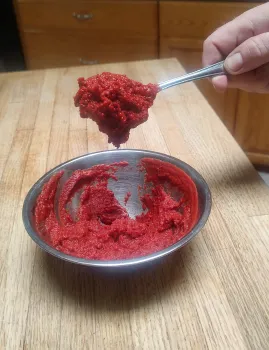Monica Gross, UC Master Food Preserver Online Program Volunteer
There are a surprising number of uses for tomato skin! This article will explain how to make a powder out of tomato skins and what to do with that powder (Fig.1). Prior to canning tomatoes, it’s necessary to remove the tomato skin. This is done by placing a few tomatoes at a time in boiling water for about one minute until their skins split. (For thick-skinned tomatoes, it helps to cut a small “x” in the blossom end of each tomato first.) After an ice water dip, the skin will slip right off. This series of articles will enlighten you on some surprising uses for those tomato skins. This month’s article will explain how to make tomato powder out of the skin and future articles will explore other uses for the lowly skin!

Figure 1. Tomato powder (Image credit: Monica Gross, 2025).
Tomato skins can be dehydrated and ground into tomato powder. The use of a dehydrator (Fig. 2) is recommended because ovens generally do not have a low enough temperature setting and the skins are easily burned at the higher oven temperatures. Place the skins on parchment paper, outer-skin side down, in a dehydrator. Arrange the skins to lay without folding over on themselves as much as possible. The skin should not touch one another. Set the temperature to 135oF and dry for 6 - 12 hours. Check at the 5th hour and remove any that are completely dried. NO moisture should remain. The skin should snap or shatter when bent. Store the dry skins temporarily in a covered container. Continue drying the skins that are not crisp. Check hourly and remove the skin when they have completed the dehydration process.

Figure 2. Dehydrator filled with tomato skin (Image credit: Monica Gross, 2025).
Next, pulverize the skins in a food processor, blender, or spice grinder to form tomato powder. Store the powder in a closed container in a cool dark place. If properly prepared and stored the powder can last for a year or more. You can simply use the powder as a seasoning or flavor enhancer in soups, stews, and baked goods. Alternatively, you can reconstitute it to make various tomato products (Fig. 3) as detailed in the table below.

Figure 3. Bowl of fresh tomato paste (Image credit: Monica Gross, 2025).
Tomato Product | Tomato Powder | Water | Product |
Tomato sauce | 1/3 Cup | 1 Cup | 8 oz Tomato sauce |
Tomato paste | 6 Tablespoons | ½ Cup | 6 oz Tomato paste |
Tomato juice | ½ Cup | 4 Cup | 32 oz Tomato juice |
For more information on dehydrating tomatoes and tomato skins, see:
